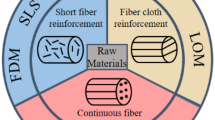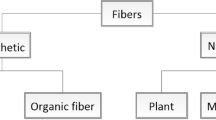Abstract
Due to the weak rigidity of thin-walled carbon fiber–reinforced plastics (CFRPs), these materials are prone to chatter during the surface milling process that results in unstable cutting. Due to the laminated and anisotropic characteristics of CFRP, different layers of materials are unevenly removed during the cutting process, which reduces the quality of the processed surface. Moreover, different fiber directions greatly affect chatter. Accordingly, the chatter of CFRP is a complicated phenomenon. Currently, conventional methods to suppress chatter have limited performance. In the present study, the influence of the fiber direction angle on chatter during the milling process of a CFRP unidirectional plate is analyzed, and the removal of different layers caused by chatter is studied. Based on the Taguchi experiment, the effects of various process parameters on flutter were analyzed. The obtained results show that the maximum amplitude can be achieved when the fiber direction angle is set to 135°. In this case, the spindle speed has the most significant effect on chatter. It is found that changing the process parameters can effectively suppress the chatter and improve the surface quality. This article provides a basis to establish theoretical models of chatter behavior in thin-walled CFRP surface milling, and find appropriate methods to suppress chatter.















Similar content being viewed by others
Availability of data and materials
The raw/processed data required to reproduce these findings cannot be shared at this time as the data also forms part of an ongoing study.
References
Chen YD, Guo XH, Zhang KD, Guo DL, Zhou CC, Gai LW (2019) Study on the surface quality of CFRP machined by micro-textured milling tools. J Manuf Processes 37:114–123. https://doi.org/10.1016/j.jmapro.2018.11.021
Silva D, Teixeira JP, Machado CM (2014) Methodology analysis for evaluation of drilling-induced damage in composites. Int J Adv Manuf Technol 71(9–12):1919–1928. https://doi.org/10.1007/s00170-014-5616-y
Hintze W, Cordes M, Koerkel G (2015) Influence of weave structure on delamination when milling CFRP. J Mater Process Tech 216:199–205. https://doi.org/10.1016/j.jmatprotec.2014.09.004
Li M, Chen L, Yang X (2021) A feasibility study on high-power fiber laser cutting of thick CFRP laminates using single-pass strategy. Opt Laser Technol. https://doi.org/10.1016/j.optlastec.2020.106889
Jiang X, Gao S, Zhang Y (2021) Prediction modeling of surface roughness in milling of carbon fiber reinforced polymers (CFRP). Int J Adv Manuf Tech 113(1–2):389–405. https://doi.org/10.1007/s00170-021-06609-2
Wang F, Zhang B, Zhao M, Cheng D, Wang Z (2019) Evolution laws of fiber-matrix interface cracks in machining of carbon fiber reinforced polymer. Int J Adv Manuf Technol 101:963–977. https://doi.org/10.1007/s00170-018-2992-8
Davim JP, Reis P (2005) Damage and dimensional precision on milling carbon fiber-reinforced plastics using design experiments. J Mater Process Tech 160(2):160–167. https://doi.org/10.1016/j.jmatprotec.2004.06.003
Kilickap E, Yardimeden A, Celik YH (2015) Investigation of experimental study of end milling of CFRP composite. Sci Eng Compos Mater 22(1):89–95. https://doi.org/10.1515/secm-2013-0143
Wang H, Sun J, Li J, Li W (2015) Roughness modelling analysis for milling of carbon fibre reinforced polymer composites. Mater Technol 30(A1):A46–A55. https://doi.org/10.1179/1753555715Y.0000000002
Arola D, Sultan MB, Ramulu M (2002) Finite element modeling of edge trimming fiber reinforced plastics. J Manuf Sci E-T Asme 124(1):32–41. https://doi.org/10.1115/1.1428329
Kruszynski BW, Lajmert P (2005) An intelligent supervision system for cylindrical traverse grinding. CIRP Ann 54:305–308. https://doi.org/10.1016/S0007-8506(07)60109-7
Marian W, Erhan B (2001) Sources of nonlinearities, chatter generation and suppression in metal cutting. Phil Trans R Soc Lond A 359:663–693. https://doi.org/10.1098/rsta.2000.0750
Altintas Y, Shamoto E, Lee P (1999) Analytical prediction of stability lobes in ball end milling. J Manuf Sci E 121(4):586–592. https://doi.org/10.1115/1.2833064
Zhao MX, Balachandran B (2001) Dynamics and stability of milling process. Int J Solids Struct 6(38):2233–2248. https://doi.org/10.1016/S0020-7683(00)00164-5
Gu D, Wei Y, Xiong B, Liu SL, Zhao DF, Wang BQ (2020) Three degrees of freedom chatter stability prediction in the milling process. J Mech Sci Technol 34(9):3489–3496. https://doi.org/10.1007/s12206-020-0801-4
Sun C, Shen X, Wang W (2016) Study on the milling stability of titanium alloy thin-walled parts considering the stiffness characteristics of tool and workpiece. Procedia CIRP 56:580–584. https://doi.org/10.1016/j.procir.2016.10.114
Kecik K, Rusinek R, Warminski J, Weremczuk A (2012) Chatter control in the milling process of composite materials. MPSVA 382. https://doi.org/10.1088/1742-6596/382/1/012012
Rusinek R, Lajmert P (2020) Chatter detection in milling of carbon fiber-reinforced composites by improved Hilbert–Huang transform and recurrence quantification analysis. Materials 13(18). https://doi.org/10.3390/ma13184105
Tian WJ (2018) Research on chatter suppression method for multi-axis machining of thin-walled blades. Dissertation, University of Northwestern Polytechnical
Cica D, Caliskan H, Panjan P, Kramar D (2020) Multi-objective optimization of hard milling using taguchi based grey relational analysis. The Vjesn 27(2):513–519. https://doi.org/10.17559/TV-20181013122208
Funding
This work is supported by the National Key R&D Program of China (Grant No. 2018YFA0702803); Liaoning Revitalization Talents Program (Grant No. XLYC1801008, XLYC1902014, XLYCYSZX1901); and Science and Technology Innovation Foundation of Dalian (Grant No. 2019CT01, 2021RD08).
Author information
Authors and Affiliations
Contributions
Fuji Wang and Jun Deng conceived and designed the study. Jun Deng and Lelin Yang performed the experiments. Jun Deng and Boyu Zhang wrote the paper. Boyu Zhang, Lelin Yang, and Yongquan Lin reviewed and edited the manuscript. All authors read and approved the manuscript.
Corresponding author
Ethics declarations
Ethical approval
Not applicable.
Consent to participate
Not applicable.
Consent to publish
The author confirms that the work has not been published before, that it is not under consideration for publication elsewhere, that its publication has been approved by all co-authors, and that its publication has been approved by the responsible authorities at the institution where the work is carried out.
Competing interests
The authors declare no competing interests.
Additional information
Publisher's Note
Springer Nature remains neutral with regard to jurisdictional claims in published maps and institutional affiliations.
Rights and permissions
Springer Nature or its licensor holds exclusive rights to this article under a publishing agreement with the author(s) or other rightsholder(s); author self-archiving of the accepted manuscript version of this article is solely governed by the terms of such publishing agreement and applicable law.
About this article
Cite this article
Wang, F., Deng, J., Zhang, B. et al. Effect of chatter on material removal during surface milling of thin-walled carbon fiber–reinforced plastic (CFRP) components. Int J Adv Manuf Technol 122, 2899–2910 (2022). https://doi.org/10.1007/s00170-022-10078-6
Received:
Accepted:
Published:
Issue Date:
DOI: https://doi.org/10.1007/s00170-022-10078-6




